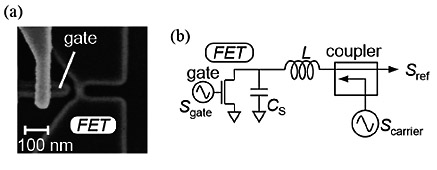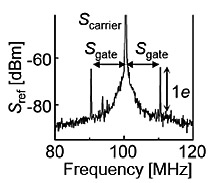Fast and High-Sensitivity Charge Sensor Combinedwith a Resonance Circuit
A field-effect transistor (FET), a device that amplifies a signal applied to a gate terminal, can be used as a sensor with a high charge sensitivity [1]. In particular, a FET with a ten-nanometer-scale channel (Fig. 1(a)) allows single-electron detection at room temperature [2]. With this capability, the FET can transmit data using one electron as one bit [3] and can detect a tiny signal in micro-electro-mechanical systems [4]. However, such a small channel makes its resistance higher, which leads to a limitation of FET operation speed (10~100 kHz). In this work, we demonstrate high-speed charge detection with single-electron resolution using a radio-frequency FET (RF-FET) [5].
In the RF-FET, an inductor L is connected to the FET and the combination of L with a stray capacitor Cs of the FET functions as an LC resonance circuit as shown in Figure 1(b). When a carrier signal Scarrier, whose frequency fcarrier is close to the resonance frequency [=1/(2πLCs)], is applied to the circuit, some part of the signal is reflected (hereafter referred to as Sref). By modulating channel resistance with gate signal Sgate whose frequency fgate is 10 MHz, the reflection characteristics of the circuit are also modulated. As a result, a side peak originating from Sgate appears on both side of the main peak from fcarrier in a Sref spectrum as shown in Fig. 2. Since Sgate power corresponds to a single-electron signal, the appearance of the two side peaks means single-electron detection at 10 MHz. This fast detection is possible because the LC circuit matches the low impendence of the circuits to the high-impedance of the small FET channel. On the other hand, a Si FET enables us to use high-power Scarrier, which leads to an increase in side-peak amplitude. And the frequencies of the side peaks, fcarrier ± fgate, are high enough to almost completely avoid 1/f noise, which typically occurs at low frequency. As a result, the RF-FET allows signal detection with a charge sensitivity of ~10–4 e/Hz0.5 up to 20 MHz. By applying Sref and Scarrier to a mixer, frequencies of the side peaks are down-converted from fcarrier ± fgate to fgate, which allows detection of Sgate with arbitrary waveforms. Such signal detection at room temperature with a combination of high charge sensitivity and fast operation enables us to use the RF-FET in a range of applications. This work was partly supported by the Funding Program for Next Generation World-Leading Researchers of JSPS.
- [1]
- M. H. Devoret and R. J. Schoelkopf, Nature 406 (2000) 1039.
- [2]
- K. Nishiguchi et al. Jpn. J. Appl. Phys. 47 (2008) 8305.
- [3]
- K. Nishiguchi et al. Appl. Phys. Lett. 88 (2006) 183101.
- [4]
- I. Mahboob et al. Appl. Phys. Lett. 95 (2009) 233102.
- [5]
- K. Nishiguchi et al. Appl. Phys. Lett. 103 (2013) 143102.
 |
 |
|
|